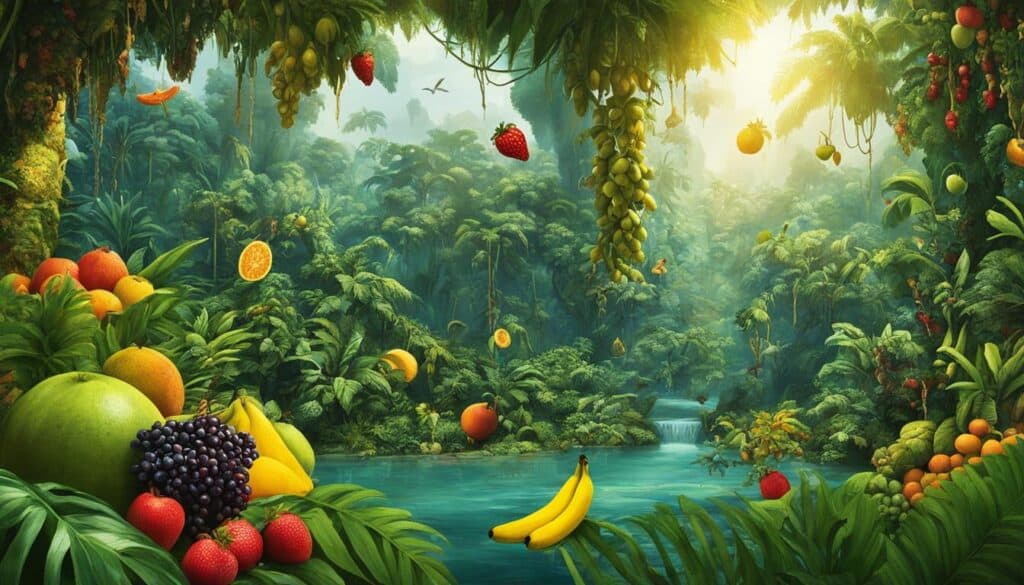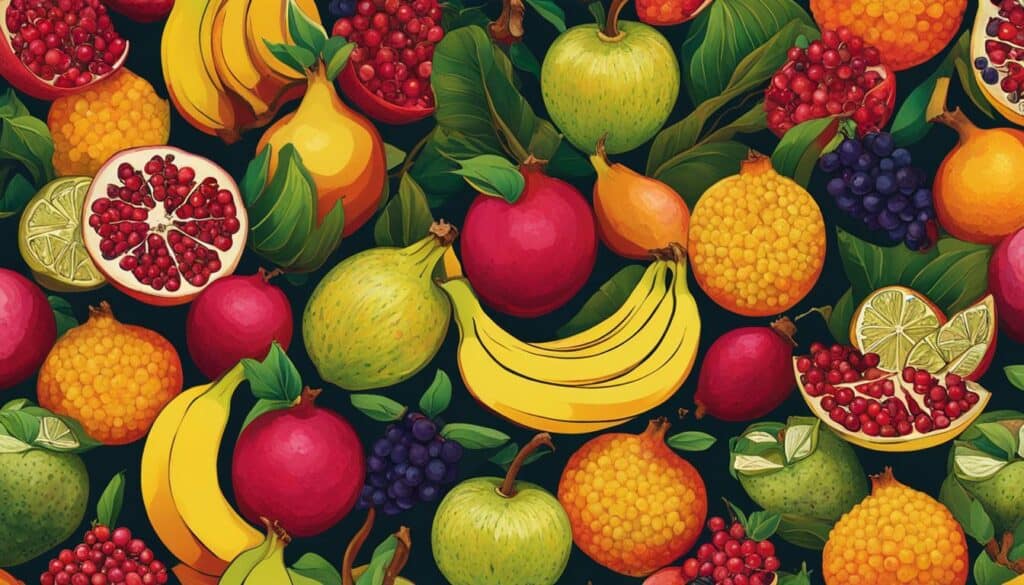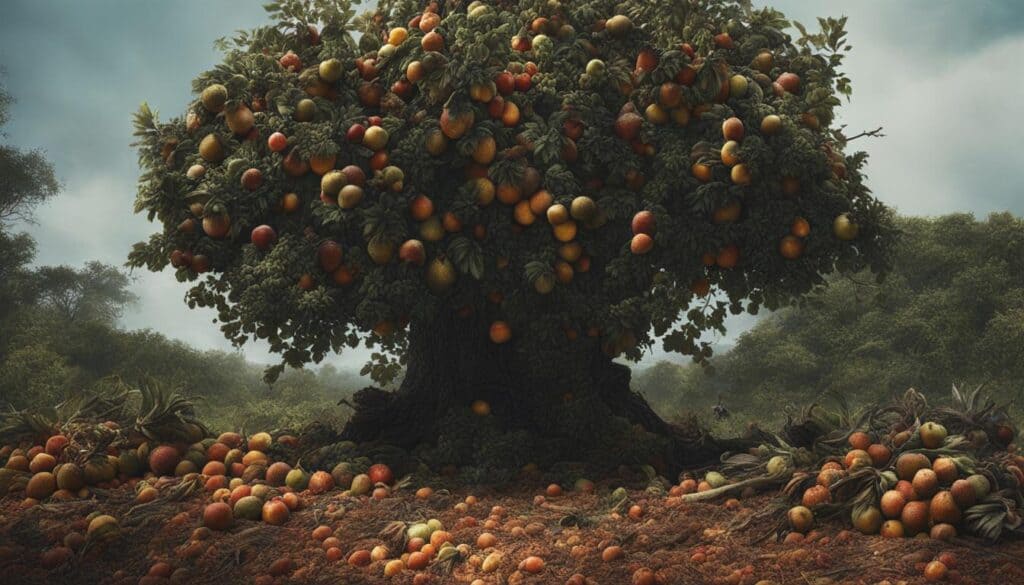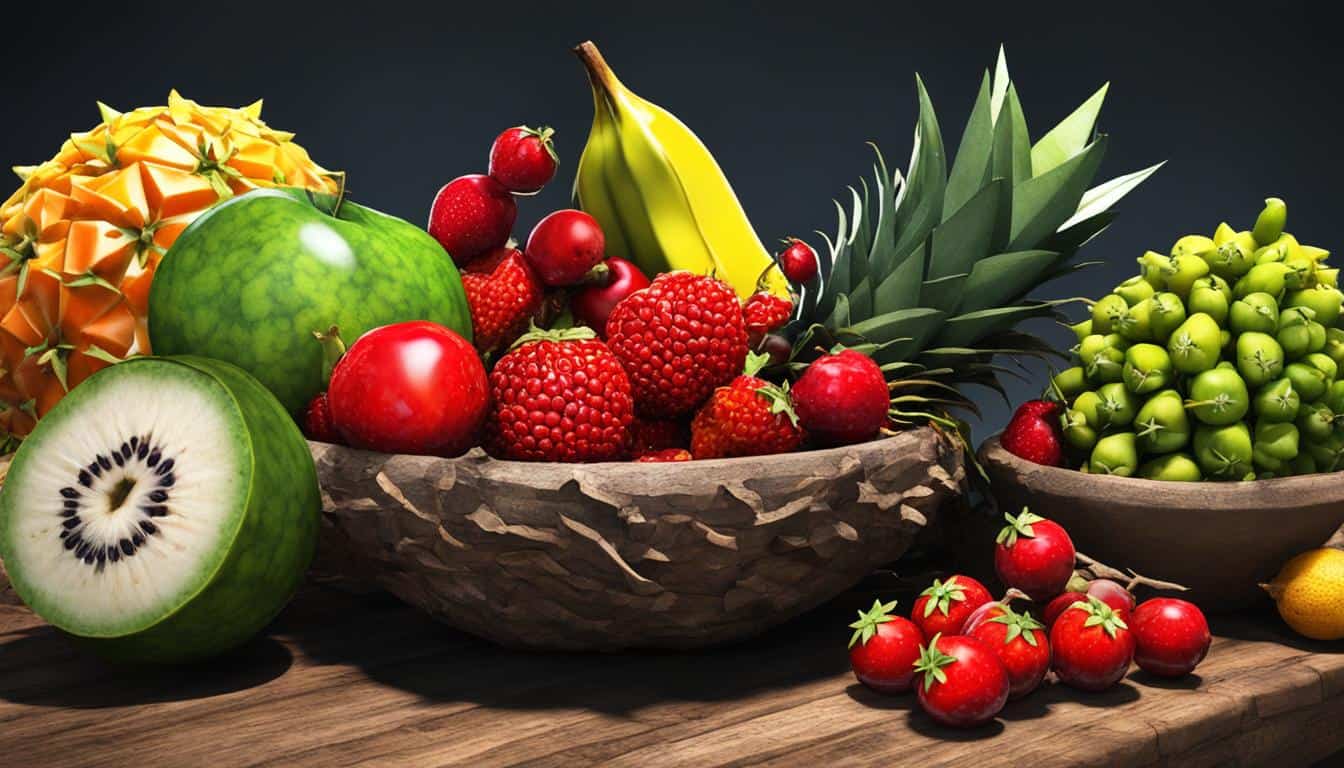Have you ever wondered how the fruit you enjoy today came to be? The evolution of fruits is a fascinating process that has shaped not only the plant kingdom but also us, humans. Fruits have undergone significant changes throughout their evolutionary history, adapting to environmental conditions and developing unique characteristics to attract animals for seed dispersal. Let’s delve into the captivating world of fruit evolution and discover the secrets behind the bountiful fruits we know and love.
- The evolution of fruits has played a crucial role in shaping various species, including humans, by providing nutritional and reproductive advantages.
- Fruits have been instrumental in the evolutionary history of many organisms, contributing to their survival and diversifying plant species.
- Fruits have developed unique adaptations, such as vibrant colors, enticing aromas, and specialized seed dispersal mechanisms, to ensure successful reproduction and colonization of new habitats.
- Fruits and animals engage in a coevolutionary relationship, influencing each other’s traits and behaviors, driving diversification and specialization.
- The consumption of fruits has been vital to human evolution, providing essential nutrients that contributed to physical and cognitive development.
The Importance of Fruits in Evolutionary History
Fruits have played an integral role in the evolutionary history of organisms, including humans. The consumption of fruits provided early humans with essential nutrients, contributing to their survival and reproductive success. But the significance of fruits goes beyond their nutritional value. The evolution of fruits, from simple structures to more complex and enticing forms, has played a vital role in attracting animals for seed dispersal, shaping the ecosystem as we know it today.
Early humans discovered the benefits of fruit consumption millions of years ago. Fruits were readily available and provided a reliable source of energy and nutrients. By consuming fruits, early humans gained a competitive advantage, which positively influenced their growth, development, and overall fitness. This reliance on fruits influenced the evolution of our species and shaped human physiology.
As fruits evolved, they developed various characteristics that attracted animals for seed dispersal. Bright colors, enticing shapes, and appealing aromas and tastes became key features of fruits, ensuring their successful propagation. Animals, in turn, were attracted to the rewards offered by fruits, such as a source of nutrition or a means of survival. This mutualistic relationship between fruits and animals allowed for the spread and diversification of plant species.
The interconnectedness between fruits and animals is evident in the coevolutionary process. Animals became specialized to consume and disperse fruits, while fruits evolved to maximize their chances of being dispersed by animals. This intricate dance of adaptation fueled the diversification of both fruit traits and animal behaviors, leading to the creation of a complex web of interactions within ecosystems.
Today, fruits continue to play a crucial role in human evolution. Although our modern diets have expanded to include a wide range of foods, the nutritional benefits of fruit consumption remain undeniable. Fruits are rich in vitamins, minerals, fiber, and antioxidants, offering numerous health benefits. The incorporation of fruits into our diets supports overall health and well-being, ensuring we receive essential nutrients for optimal performance.
The Benefits of Fruit Consumption
The consumption of fruits provides us with a range of benefits:
- Rich in vitamins and minerals: Fruits are packed with essential vitamins and minerals that support various bodily functions.
- Dietary fiber: Fruits are a great source of dietary fiber, promoting healthy digestion and reducing the risk of chronic diseases.
- Antioxidants: Fruits contain powerful antioxidants that help protect our bodies against cellular damage caused by free radicals.
- Hydration: Many fruits have high water content, aiding in hydration and maintaining optimal body fluid balance.
- Weight management: The high fiber content and low-calorie density of fruits can contribute to weight management and satiety.
By incorporating a variety of fruits into our daily diets, we can reap these benefits and support our overall health and well-being.
The Role of Fruits in Human Evolution
Fruits have not only shaped our evolutionary past but continue to impact our present and future. The consumption of fruits has influenced our dietary preferences and behaviors, leading to the development of advanced cognitive abilities and the expansion of our brain size. Fruits were a reliable food source for early humans, especially during times of scarcity, contributing to our survival and reproductive success.
As we look ahead, fruits remain essential in our modern diet. Health organizations recommend consuming a variety of fruits to meet our nutritional needs. The health benefits associated with fruit consumption are undeniable, making fruits an integral part of a balanced and nutrient-rich diet.
In the next section, we’ll explore the evolutionary adaptations that fruits have developed to enhance their chances of successful seed dispersal and survival.
Evolutionary Adaptations of Fruits
Fruits have evolved unique adaptations to increase their chances of successful seed dispersal. These adaptations include:
- Bright colors and attractive shapes: Fruits have developed vibrant hues and intriguing shapes to catch the attention of animals. This visual appeal serves as a signal for potential dispersers to locate and consume the fruit.
- Aromas and tastes: Fruits produce enticing scents and flavors to attract animals. The irresistible aroma and delicious taste make the fruit more appealing, encouraging animals to consume it.
- Seed dispersal mechanisms: Fruits have evolved diverse mechanisms to ensure the effective dispersal of their seeds:
| Seed Dispersal Mechanism | Example |
|---|---|
| Floating in water | Coconut (Cocos nucifera) |
| Sticking to fur or feathers | Burdock (Arctium spp.) |
| Passing through digestive system | Wild cherry (Prunus avium) |
These adaptations enable fruits to effectively disperse their seeds to new habitats, increasing their chances of survival and diversification.
To visually illustrate the concept of fruit adaptations, here is an image that showcases the diverse colors and shapes found in a variety of fruits:
I find it fascinating how fruits have evolved these remarkable adaptations to entice animals and ensure the dispersal of their seeds. From their vibrant colors and enticing aromas to their unique seed dispersal mechanisms, each fruit has its own ingenious strategies. This coevolutionary relationship between fruits and animals is truly remarkable.
Importance of Fruit Colors and Shapes
The diverse colors and shapes of fruits play a vital role in attracting animal dispersers. Bright colors such as red, orange, and yellow are commonly associated with ripeness and indicate the presence of nutrients. Animals, particularly birds and mammals, are drawn to these colors as a signal of nutritional value.
Similarly, the unique shapes of fruits serve different purposes. Some fruits have elongated structures that facilitate dispersal by wind, while others have hooks or barbs that allow them to cling to the fur or feathers of animals. By adapting their colors and shapes, fruits optimize their chances of catching the attention of potential dispersers and ensuring successful seed dispersal.
Aromas and Tastes: Nature’s Allure
The aromas and tastes of fruits are nature’s way of enticing animals to consume them. Fruits produce a wide range of scents, from sweet and floral to musky and tangy, to attract specific animal species. For example, some fruits emit a strong scent that specifically appeals to nocturnal animals or certain insect pollinators.
The delightful taste of fruits further enhances their appeal to animals. The combination of sugars, acids, and other compounds creates a delectable experience that encourages animals to consume the fruit and disperse the seeds through their feces or by spitting them out. This mutually beneficial relationship between fruits and animals has shaped the evolution of both groups.
These adaptations demonstrate the intricate strategies fruits have developed over millions of years to ensure their survival and reproduction. By adapting their colors, shapes, aromas, and tastes, fruits have effectively attracted animal dispersers, facilitating the dispersal of their seeds and contributing to the richness and diversity of our ecosystems.
The Coevolution of Fruits and Animals
Fruits and animals have engaged in a fascinating coevolutionary dance, where each influences the traits and behaviors of the other. Through millions of years of interactions, fruits and fruit-feeding animals, such as birds, mammals, and insects, have shaped each other’s evolutionary paths. This intricate relationship has led to the development of extraordinary adaptations and complex mutualistic relationships.
One of the key driving forces behind the evolution of fruits is their interactions with fruit-feeding animals. As animals consume fruits, they inadvertently disperse the plant’s seeds, aiding in their dispersal and colonization of new habitats. In response, fruits have evolved diverse defense mechanisms to attract more effective seed dispersers while deterring less efficient ones. These defense mechanisms can include thorns, toxins, and hard exteriors that discourage less specialized animals from accessing the fruits.
“The intricate dance between fruits and animals has resulted in a remarkable array of defense mechanisms and specialized adaptations.”
On the other side of this relationship, animals have also adapted to the availability and characteristics of fruits. Different species of fruit-feeding animals have evolved varied feeding behaviors and physical traits to access and consume fruits efficiently. They have developed specialized bill shapes, beak sizes, teeth, and digestive systems to exploit the nutritional benefits offered by different types of fruits. This mutualistic relationship between fruits and animals has facilitated the diversification and specialization of both groups over time.
The coevolution of fruits and fruit-feeding animals has given rise to an astonishing variety of interactions, often involving specific traits and behaviors. For example, some fruits have evolved bright colors and enticing aromas to attract specific pollinators or seed dispersers. Others have developed structures that entice animals by mimicking the appearance of food or providing a comfortable resting place. These adaptations highlight the remarkable diversity and sophistication of the coevolutionary relationship between fruits and animals.
The Mutualistic Dance between Orchids and Insects
An exceptional example of coevolution between fruits and animals can be observed in the intricate relationship between orchids and insects. Orchids have evolved intricate flower structures, colors, and scents to attract specific insect pollinators. In turn, these pollinators have adapted to access the nectar hidden within the orchid’s flowers, forming a mutualistic partnership that ensures the orchids’ reproduction and the insects’ access to a valuable food source.
Overall, the coevolution of fruits and animals has resulted in an ongoing dialogue of traits and adaptations, driving the dynamic evolution of both groups. The complex interactions between fruits and fruit-feeding animals continue to shape ecosystems and contribute to the remarkable biodiversity we see today.

| Fruit Defense Mechanisms | Examples |
|---|---|
| Physical Defense |
|
| Chemical Defense |
|
| Behavioral Defense |
|
Fruits and Human Evolution
Fruits have played a crucial role in the evolution of humans. The consumption of fruits provided early humans with essential vitamins, minerals, and carbohydrates, contributing to their physical and cognitive development. Fruits were a reliable source of nutrition, especially during periods when other food sources were scarce.
The inclusion of fruits in the human diet allowed for the expansion of the brain and the development of advanced cognitive abilities. Early humans relied on fruits as a significant part of their diet, and this reliance shaped their dietary preferences and behaviors. The nutritional benefits of fruit consumption were key factors in the survival and evolutionary success of our ancestors.
Today, we have a better understanding of the role fruits played in human evolution. Research has shown that the consumption of fruits provided early humans with crucial nutrients, aiding in their overall growth and development. The diverse array of vitamins and minerals found in fruits supported their immune system, enhanced their physical strength, and promoted brain function.
“The nutritional benefits of fruits, combined with their natural sweetness, made them an attractive food source for our early ancestors.”
Additionally, fruits offered early humans a source of hydration, as many fruits contain high water content. This allowed early humans to thrive in diverse environments, adapting to different climates and successfully populating new regions of the world.

Fruits not only provided essential nutrients but also contributed to the cultural and social aspects of early human societies. Gathering and sharing fruits brought communities together, fostering cooperation and a sense of belonging. The consumption of fruits became a communal activity, strengthening social bonds and facilitating the exchange of knowledge and experiences.
In summary, the role of fruits in human evolution cannot be overstated. The nutritional benefits of fruit consumption supported the physical and cognitive development of early humans, contributing to their evolutionary success. Fruits provided essential nutrients, hydration, and a sense of community, shaping the dietary preferences and behaviors of our early ancestors.
| Fruit | Vitamin C (mg) | Vitamin A (IU) | Potassium (mg) |
|---|---|---|---|
| Oranges | 69.7 | 270 | 232 |
| Apples | 0.5 | 73 | 107 |
| Bananas | 8.7 | 76 | 422 |
| Grapes | 0.3 | 32 | 191 |
Fruits and Modern Human Diet
Fruits continue to play a crucial role in the modern human diet, offering a wide range of health benefits and nutritional value. Incorporating a variety of fruits into our daily meals is essential for maintaining a balanced and nutritious diet.
The importance of fruits in the modern diet cannot be emphasized enough. They are packed with essential vitamins, minerals, fiber, and antioxidants that promote good health and well-being. Consuming fruits regularly has been associated with a reduced risk of chronic diseases, including cardiovascular diseases and certain types of cancer.
Health organizations recommend a daily intake of fruits as part of a nutrient-rich diet. The exact amount of fruits required may vary based on individual needs, but a general guideline is to aim for around 2 to 3 servings of fruits per day.
By incorporating a variety of fruits into our meals, we can ensure that we receive a diverse range of nutrients and enjoy the unique flavors and textures that each fruit has to offer. Experimenting with different types of fruits not only adds excitement to our meals but also provides a wide array of health benefits.
| Health Benefits of Fruit Consumption |
|---|
| Improved digestion and gut health |
| Boosted immune system |
| Reduced inflammation |
| Enhanced brain function |
| Lowered risk of heart disease |
| Increased energy levels |
In addition to their health benefits, fruits are also a delicious and refreshing way to stay hydrated, especially during hot summer months. They can be enjoyed as a snack, added to smoothies, salads, or used as natural sweeteners in various recipes.
To make the most of the benefits fruits offer, it’s important to choose a variety of colors and types of fruits. Each color represents different phytonutrients, which have unique health-promoting properties. By selecting a rainbow of fruits, we can maximize our intake of these beneficial compounds.
Remember, fruits are not only delicious, but they also contribute significantly to our overall health and well-being. So, make sure to include a generous portion of fruits in your daily diet and enjoy the flavorful journey to a healthier lifestyle.
The Cultural Significance of Fruits
Fruits have played a significant role in shaping cultural beliefs and traditions across various societies throughout history. Symbolizing abundance, fertility, and prosperity, fruits hold a special place in religious and mythological practices.
In religious rituals and ceremonies, fruits are often used as offerings to deities or as symbols of divine blessings. They are considered sacred and are believed to bring luck and good fortune. Fruits are also used in traditional ceremonies to mark important milestones and events, such as weddings, births, and harvest festivals.
“Fruits have been revered by different cultures for their symbolic meanings and their connection to the natural world. They serve as a reminder of the cycles of life and the abundance that nature provides.”
Specific fruits hold unique symbolism in different cultures. For example, the apple is commonly associated with temptation and knowledge in Christian mythology, while the pomegranate is seen as a symbol of fertility and prosperity in many Middle Eastern cultures. The banana is considered a sacred fruit in Hinduism, representing the Hindu god Vishnu.

Fruit festivals and traditions also play a significant role in celebrating the cultural importance of fruits. These festivals often include parades, performances, and the creation of elaborate displays using fruits. They provide an opportunity for communities to come together, express gratitude for the bountiful harvest, and celebrate the cultural heritage associated with fruits.
In conclusion, the cultural significance of fruits is deeply rooted in our history and continues to shape our beliefs and traditions. Fruits serve as powerful symbols of abundance, fertility, and prosperity in religious and mythological contexts. They are integral to various cultural practices, festivals, and ceremonies, representing the interconnectedness of humans with the natural world.
Environmental Impacts and Conservation Concerns
The production and consumption of fruits have a significant impact on the environment. From the use of pesticides to the depletion of water resources and the conversion of land, fruit production can contribute to environmental degradation. However, sustainable farming practices offer a solution to minimize these impacts and promote environmentally friendly fruit production.
Organic farming and agroecology are two sustainable farming practices that prioritize ecological balance and resource conservation. By reducing the use of synthetic pesticides and fertilizers, organic farming minimizes the negative impact on soil health and water quality. Agroecology, on the other hand, focuses on building resilient ecosystems that support diverse plant and animal species while enhancing soil fertility naturally.
“Sustainable farming practices not only protect the environment but also have positive impacts on the quality and nutritional value of the fruits produced,” says Dr. Rebecca Summers, a renowned environmental scientist specializing in sustainable agriculture.
“Farming methods that support natural pollinators, like bees and butterflies, contribute to biodiversity conservation and ensure the success of fruit production.”
The conservation of fruit diversity is of utmost importance for maintaining ecosystem resilience and preserving unique genetic resources. Many fruit species have become rare or endangered due to habitat loss and unsustainable agricultural practices. Efforts are being made to identify and protect these rare species through conservation programs and seed banks.
In a study led by Dr. Amanda Martinez, a prominent conservation biologist, it was found that the conservation of fruit diversity is essential for maintaining a robust food system and adapting to environmental changes. “Preserving the diversity of fruits not only ensures the availability of different flavors and nutritional profiles but also guards against the potential loss of important genetic traits that could be crucial for future crop development,” says Dr. Martinez.
To illustrate the impact of fruit production on the environment and the need for conservation, consider the following table:
| Fruit Production Method | Environmental Impact | Conservation Efforts |
|---|---|---|
| Conventional farming | Heavy use of synthetic pesticides and fertilizers, leading to pollution of water bodies. Land conversion and habitat loss. | Implementation of integrated pest management practices, restoration of natural habitats, and seed banks for endangered fruit species. |
| Organic farming | Minimized use of synthetic pesticides and fertilizers, promotes soil health and biodiversity. | Certification programs for organic farming, support for organic farmers, and conservation of heirloom fruit varieties. |
| Agroecology | Focuses on ecological balance and resource conservation, promotes biodiversity and ecosystem health. | Research and education on agroecological practices, conservation of wild fruit species. |
As the demand for fruits continues to rise, it is essential to adopt sustainable farming practices and prioritize the conservation of fruit diversity. By doing so, we can mitigate the environmental impacts of fruit production and ensure the long-term survival of diverse fruit species for future generations.

Future Directions in Fruit Evolution Research
The field of fruit evolution research is constantly evolving, unraveling the intricacies of fruit development and adaptation. Genetic studies and breeding programs play a crucial role in this research, allowing us to enhance fruit quality, improve nutritional content, and increase disease resistance. Through these endeavors, we are unlocking the potential of fruits to meet the ever-changing demands of our society.
However, the future of fruit evolution research is not without its challenges. Climate change poses a significant threat, as shifting temperatures and unpredictable weather patterns can impact fruit production and diversity. Habitat loss is another pressing concern, as it diminishes the natural environments where fruits thrive and limits their potential for evolution. To address these challenges, researchers are exploring sustainable agricultural practices, conservation efforts, and the development of resilient fruit varieties.
Amidst these challenges, opportunities for innovation abound. Advancements in technology, such as genome sequencing and genetic modification, offer new avenues for understanding and enhancing fruit evolution. Furthermore, the need for conservation raises awareness about the importance of preserving rare and endangered fruit species, fostering biodiversity and ensuring their survival for future generations.
The future of fruit evolution research holds immense promise. By harnessing the power of genetic studies, breeding programs, and innovative approaches, we can unlock the untapped potential of fruits. Together, through our collective efforts, we can shape a future where fruits play an even greater role in nourishing and sustaining the well-being of our planet and its inhabitants.
FAQ
What is the significance of fruits in evolutionary history?
Fruits have played a crucial role in the evolution of many organisms, including humans. They have provided essential nutrients for survival and reproductive success, as well as played a key role in attracting animals for seed dispersal.
How have fruits adapted throughout evolution?
Fruits have developed various adaptations to enhance their chances of successful seed dispersal. These adaptations include the evolution of bright colors, attractive shapes, appealing aromas, and tastes. They also have unique seed dispersal mechanisms, such as floating in water, sticking to fur or feathers, and being ingested and passed through the digestive system of animals.
How have fruits and animals influenced each other through coevolution?
Fruits and animals have engaged in a coevolutionary relationship in which their traits and behaviors have influenced each other. Fruits have developed defense mechanisms to attract effective seed dispersers while deterring less effective ones. Animal feeding behavior has also been influenced by the availability and characteristics of fruits.
How have fruits shaped human evolution?
The consumption of fruits by early humans provided essential nutrients for physical and cognitive development, contributing to their survival and reproductive success. Fruits were a reliable source of nutrition, especially during times of food scarcity. The reliance on fruits shaped the dietary preferences and behaviors of our early ancestors.
What are the health benefits of consuming fruits?
Regular fruit consumption is associated with a reduced risk of chronic diseases, such as cardiovascular diseases and certain types of cancer. Fruits are rich in vitamins, minerals, fiber, and antioxidants, providing numerous health benefits. Health organizations recommend incorporating a variety of fruits into a nutrient-rich diet.
What is the cultural significance of fruits?
Fruits have held cultural significance throughout history and across different societies. They have been symbolically associated with abundance, fertility, and prosperity in various religious and mythological beliefs. Fruits are often featured in religious rituals, festivals, and traditional ceremonies.
What are the environmental impacts and conservation concerns associated with fruit production?
The production and consumption of fruits can have environmental impacts, such as the use of pesticides, water resources, and land conversion. Sustainable farming practices aim to minimize these impacts. Additionally, the conservation of fruit diversity is important for ecosystem resilience and the preservation of unique genetic resources.
What is the future direction of fruit evolution research?
Fruit evolution research continues to advance our understanding of the processes and mechanisms involved in fruit development and adaptation. Genetic studies and breeding programs are instrumental in improving fruit quality and disease resistance. Future research will face challenges such as climate change and habitat loss, but also presents opportunities for innovation and conservation.





Leave a Reply